 Mars
Mars CCD Astronomy
Planetary
Images
.2 sec. exposures, average of 3, 2 and 3 frames with 6" AP and MX5c at
f/21. May 19, 1999, Valencia, CA. South is to the upper right
Seeing was fair-good three nights in a row. In these shots, which were
all
made during a 22 minute period, Syrtis Major is at the top and the
North
Polar Cap is at the lower left.
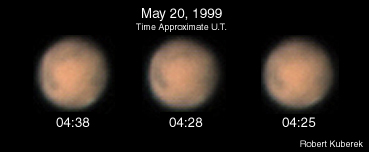 Mars
Mars
Here they are again resampled to 200% to simulate f/42 and rotated so
that south is up.
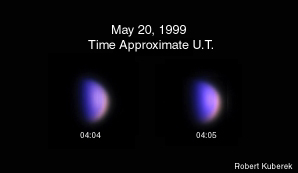 Venus
Venus
.5 sec. exposures with 6" AP and MX5c camera at f/21. May 19, 1999,
Valencia, CA. #47 filter and IRX (infrared block). Each image is an average
of two images.
The more I observe Venus, the more fascinating and mysterious it
becomes.
These images hint at some structure in the lower right hand
portion of the disk,
where a dark, wedge-shaped feature is visible in both
image sets.
Venus is completely cloud covered. The atmosphere of Venus is 96% CO2
and 3.5% N2. Sort of an ultimate greenhouse. Hot, dry, cloudy and generally
unpleasant (to us, at least).
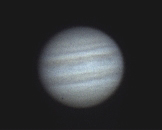 Jupiter
Jupiter
.5 Second Exposure with 8" LX200 at f/30, MX5c. November 4, 1998,
Valencia, CA.
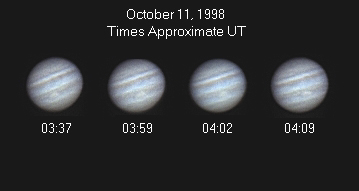 Jupiter Sequence
Jupiter Sequence
.5-.7 sec. exposure with 8" LX200 at Approx. f/20, MX5c camera. October
10, 1998, Valencia, CA.
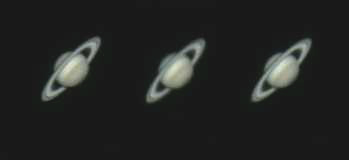 Saturn Sequence
Saturn Sequence
1 sec. exposure with 8" LX200 at f/30, MX5c camera. November 22, 1998,
Valencia, CA.
 Jupiter And Moons
Jupiter And Moons
Jupiter with Great Red Spot and Three Moons. .05 sec. exposure with 4"
Traveler,
ST7. September 18, 1998, Valencia, CA